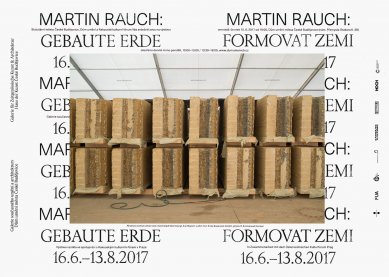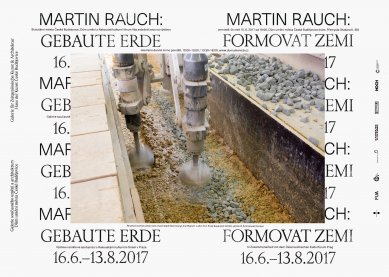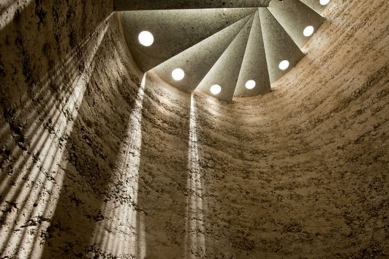
Martin Rauch: Shaping the Earth / Refined Earth - invitation to the vernissage
Source
Michal Škoda, DUČB
Michal Škoda, DUČB
Publisher
Tisková zpráva
15.06.2017 08:55
Tisková zpráva
15.06.2017 08:55
Czech Republic
České Budějovice
Martin Rauch
Lehm Ton Erde Baukunst
Gallery of Contemporary Art and Architecture – House of Art of the City of České Budějovice
Opening: Thursday, June 15, 2017 / from 6:00 PM
Duration: June 16 – August 13, 2017
Curator: Michal Škoda
For this year's summer months, we have prepared a project addressing the increasingly relevant topic of using clay (earth) in contemporary architecture. This exhibition presents one of the most respected figures in the current European scene – Martin Rauch, who has been working with clay architecture for many years.
The use of clay as a building material is as old as human history itself. Nevertheless, this material is contemporary, perhaps more than any other, thanks to its construction-physical and ecological properties.
Martin Rauch, together with his company Lehm Ton Erde, has been developing new techniques and implementing projects using rammed earth for 30 years. An important part of this development is not only the continuous improvement of the construction and the expansion of possibilities but also the connection with contemporary architecture and aesthetics. In collaboration with renowned foreign artists and architectural studios, such as Theo Lüthi, Roger Boltshauser, Herzog & de Meuron, Marte Marte, Olafur Eliasson, Simon Starling, building works and installations have emerged that have influenced this technology not only technically but also creatively.
Lehm – Ton – Erde. These three words not only describe Martin Rauch's activities but also have a symbolic meaning for him as they capture his comprehensive philosophy: LEHM expresses craft and technology, TON artistic interpretation, ERDE ecological sustainability of clay construction.
Martin Rauch was born in Schlins in 1958 – in the Austrian Vorarlberg. From 1978 to 1983, he studied at the University of Applied Arts in Vienna, in the master's class of ceramics under Prof. Matteo Thun and Prof. Maria Bilger-Perze. Since 1984, he has been engaged in the conception, planning, and realization of clay building projects both domestically and abroad. The year 1999 was the year of the founding of Lehm Ton Erde, Baukunst GmbH. Rauch has numerous solo and collective exhibitions to his name, including in Feldkirch, Merano, Paris, Graz, Venice, and he is also the holder of numerous awards - just to name a few - the International Award for Sustainable Architecture Fassa Bortolo Italy 2008, the Builder’s Prize of the Central Association of Architects of Austria - 2008 Holcim Award 2011 – School of Sustainable Development in Morocco. He has also led numerous international workshops – among others in Bangladesh, South Africa, and Austria in collaboration with BASEhabitat. Since 2010, he has served as an honorary professor at the UNESCO "Earthen Architecture" department and since 2014 has been a visiting lecturer at the architecture department of ETH Zurich.
The exhibition, in which Martin Rauch will be presenting himself for the first time in the Czech Republic, is specially prepared directly for the spaces of the House of Art of České Budějovice Gallery. This is a project offering a look into "Shaping the Earth," and it will also include works that were created during a few days during the installation and preparation of the exhibition itself – as part of a workshop with architecture students who worked under Rauch's guidance directly in České Budějovice.
"Martin Rauch discovered earthen architecture not through architecture itself but through his studies and his first projects as a ceramicist, kiln builder, and sculptor. His interest in applied crafts, the complete artistic autonomy of life, and environmental design was predetermined by the rural roots of his family in Vorarlberg, although Martin Rauch received decisive impulses abroad when, like his older siblings, he spent several months on a working stay as a volunteer in Africa. In encountering 'primitive' means and building techniques in simple cycles and optimal resource utilization, he simultaneously observed how these means were brutally replaced by technologies from the first world war, which were extremely complex, ecologically much worse, difficult to repair, and not recyclable. In Africa, the artistic impulse gained a global perspective for him. His subjective tendency to work with earth – primitive artistic material – found its goal and conceptual framework. Molding clay grew into a desire to create architectural designs from earth. From shaping tiles and kilns emerged creation and construction on a large scale within the transformation of clay into residential (spatial) forms. Instead of submitting a tea set that Matteo Thun requested as a diploma project at the University of Applied Arts in Vienna, Martin Rauch presented a study on the potential of earthen building. His interest focused from the very beginning on rammed earth techniques, on a method by which the material was not additionally clad or enhanced. Just as in the case of unburned ceramics or ceramics fired at low temperatures, the construction of unplastered buildings from rammed earth (as well as in the case of buildings that Rauch encountered among anonymous agricultural buildings in France) directly led to its own expression. The layered construction of the wall simultaneously weaves the ornament of its own appearance. The clean construction, color, and haptics of the material remain unchanged and intensely preserved in the process of shaping and compression. With the sensitivity of ceramics to composition and the physicochemical conditions and effects on the material, Rauch set out to transform the language of clay as a building material to exhaust all aspects of earthen material, thus technical progress went hand in hand with formal complexity. Step by step, he experimented with a mixture of natural materials and further worked on improving their quality, compression techniques, and shaping of the cladding, and developed old techniques by further utilizing additional layers of reinforcement, but without abandoning their structural framework. Completely new tools, framework forms, and working techniques were developed; test walls were built, and the experiences gained during the independent realization of buildings were immediately utilized in each subsequent series of tests."
More information >
Opening: Thursday, June 15, 2017 / from 6:00 PM
Duration: June 16 – August 13, 2017
Curator: Michal Škoda
For this year's summer months, we have prepared a project addressing the increasingly relevant topic of using clay (earth) in contemporary architecture. This exhibition presents one of the most respected figures in the current European scene – Martin Rauch, who has been working with clay architecture for many years.
The use of clay as a building material is as old as human history itself. Nevertheless, this material is contemporary, perhaps more than any other, thanks to its construction-physical and ecological properties.
Martin Rauch, together with his company Lehm Ton Erde, has been developing new techniques and implementing projects using rammed earth for 30 years. An important part of this development is not only the continuous improvement of the construction and the expansion of possibilities but also the connection with contemporary architecture and aesthetics. In collaboration with renowned foreign artists and architectural studios, such as Theo Lüthi, Roger Boltshauser, Herzog & de Meuron, Marte Marte, Olafur Eliasson, Simon Starling, building works and installations have emerged that have influenced this technology not only technically but also creatively.
Lehm – Ton – Erde. These three words not only describe Martin Rauch's activities but also have a symbolic meaning for him as they capture his comprehensive philosophy: LEHM expresses craft and technology, TON artistic interpretation, ERDE ecological sustainability of clay construction.
Martin Rauch was born in Schlins in 1958 – in the Austrian Vorarlberg. From 1978 to 1983, he studied at the University of Applied Arts in Vienna, in the master's class of ceramics under Prof. Matteo Thun and Prof. Maria Bilger-Perze. Since 1984, he has been engaged in the conception, planning, and realization of clay building projects both domestically and abroad. The year 1999 was the year of the founding of Lehm Ton Erde, Baukunst GmbH. Rauch has numerous solo and collective exhibitions to his name, including in Feldkirch, Merano, Paris, Graz, Venice, and he is also the holder of numerous awards - just to name a few - the International Award for Sustainable Architecture Fassa Bortolo Italy 2008, the Builder’s Prize of the Central Association of Architects of Austria - 2008 Holcim Award 2011 – School of Sustainable Development in Morocco. He has also led numerous international workshops – among others in Bangladesh, South Africa, and Austria in collaboration with BASEhabitat. Since 2010, he has served as an honorary professor at the UNESCO "Earthen Architecture" department and since 2014 has been a visiting lecturer at the architecture department of ETH Zurich.
The exhibition, in which Martin Rauch will be presenting himself for the first time in the Czech Republic, is specially prepared directly for the spaces of the House of Art of České Budějovice Gallery. This is a project offering a look into "Shaping the Earth," and it will also include works that were created during a few days during the installation and preparation of the exhibition itself – as part of a workshop with architecture students who worked under Rauch's guidance directly in České Budějovice.
"Martin Rauch discovered earthen architecture not through architecture itself but through his studies and his first projects as a ceramicist, kiln builder, and sculptor. His interest in applied crafts, the complete artistic autonomy of life, and environmental design was predetermined by the rural roots of his family in Vorarlberg, although Martin Rauch received decisive impulses abroad when, like his older siblings, he spent several months on a working stay as a volunteer in Africa. In encountering 'primitive' means and building techniques in simple cycles and optimal resource utilization, he simultaneously observed how these means were brutally replaced by technologies from the first world war, which were extremely complex, ecologically much worse, difficult to repair, and not recyclable. In Africa, the artistic impulse gained a global perspective for him. His subjective tendency to work with earth – primitive artistic material – found its goal and conceptual framework. Molding clay grew into a desire to create architectural designs from earth. From shaping tiles and kilns emerged creation and construction on a large scale within the transformation of clay into residential (spatial) forms. Instead of submitting a tea set that Matteo Thun requested as a diploma project at the University of Applied Arts in Vienna, Martin Rauch presented a study on the potential of earthen building. His interest focused from the very beginning on rammed earth techniques, on a method by which the material was not additionally clad or enhanced. Just as in the case of unburned ceramics or ceramics fired at low temperatures, the construction of unplastered buildings from rammed earth (as well as in the case of buildings that Rauch encountered among anonymous agricultural buildings in France) directly led to its own expression. The layered construction of the wall simultaneously weaves the ornament of its own appearance. The clean construction, color, and haptics of the material remain unchanged and intensely preserved in the process of shaping and compression. With the sensitivity of ceramics to composition and the physicochemical conditions and effects on the material, Rauch set out to transform the language of clay as a building material to exhaust all aspects of earthen material, thus technical progress went hand in hand with formal complexity. Step by step, he experimented with a mixture of natural materials and further worked on improving their quality, compression techniques, and shaping of the cladding, and developed old techniques by further utilizing additional layers of reinforcement, but without abandoning their structural framework. Completely new tools, framework forms, and working techniques were developed; test walls were built, and the experiences gained during the independent realization of buildings were immediately utilized in each subsequent series of tests."
Otto Kapfinger
More information >
The English translation is powered by AI tool. Switch to Czech to view the original text source.



0 comments
add comment















